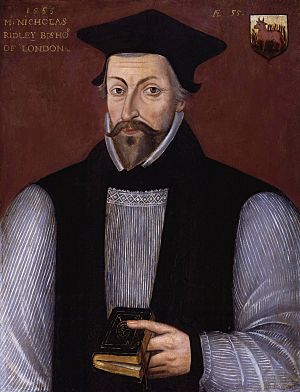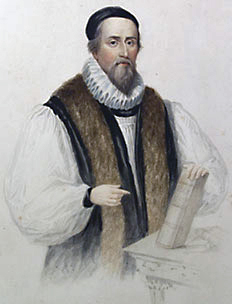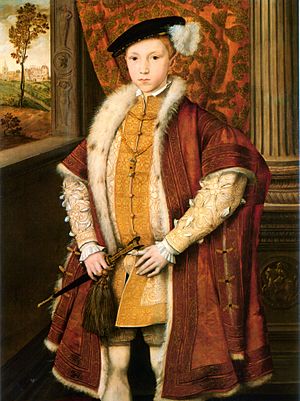Nicholas Ridley (martyr) facts for kids
Quick facts for kids The Right Reverend |
|
|---|---|
| Bishop of London and Westminster | |
 |
|
| Church | Church of England |
| Enthroned | 1550 |
| Reign ended | 1553 |
| Predecessor | Edmund Bonner, Bishop of London |
| Successor | Edmund Bonner, Bishop of London |
| Other posts | Bishop of Rochester (1547–1550) |
| Orders | |
| Consecration | 5 September 1547 by Henry Holbeach |
| Personal details | |
| Birth name | Nicholas Ridley |
| Born | c. 1500 South Tynedale, Northumberland, England |
| Died | 16 October 1555 Oxford, Oxfordshire, England |
| Denomination | Anglicanism |
| Sainthood | |
| Feast day | 16 October |
| Venerated in | Anglican Communion |
| Title as Saint | Oxford Martyr |
Nicholas Ridley (born around 1500 – died 16 October 1555) was an English Bishop of London. He was the only bishop known as "Bishop of London and Westminster." Ridley was one of the Oxford Martyrs. He was burned at the stake during the Marian Persecutions because of his beliefs. He also supported Lady Jane Grey.
Today, Nicholas Ridley is remembered on 16 October in the calendar of saints of the Church of England. He is honored alongside Hugh Latimer.
Contents
Early Life and Becoming a Leader
Nicholas Ridley came from an important family in Tynedale, Northumberland. He was the second son of Christopher Ridley. He grew up in Unthank Hall, which was built on the site of an old watch tower.
As a boy, Ridley went to the Royal Grammar School, Newcastle. He then studied at Pembroke College, Cambridge. He earned his Master of Arts degree in 1525. Soon after, he became a priest. He continued his studies in Paris at the Sorbonne.
Around 1529, Ridley returned to England. He became a senior leader at Cambridge University in 1534. At this time, people were debating the Pope's power. Ridley was very good at understanding the Bible. He helped the university decide that the Pope had no more power in England than any other foreign bishop.
In 1537, he earned his Bachelor of Divinity degree. Thomas Cranmer, the Archbishop of Canterbury, chose him to be one of his helpers. In 1538, Cranmer made him the vicar of Herne.
In 1540, Ridley became one of the King's Chaplains. He also received a special position at Canterbury Cathedral. In 1540, he became the Master of Pembroke College. He earned his Doctor of Divinity degree in 1541. In 1543, he was accused of heresy (having beliefs against church teachings). But he was able to prove his innocence.
Archbishop Cranmer wanted to support the English Reformation. This was a time when the Church in England changed away from the Roman Catholic Church. Cranmer slowly replaced older church leaders with those who supported the new ideas. Ridley became the Bishop of Rochester in 1547. Soon after, he ordered churches in his area to remove their altars. He had them put tables in their place for the Lord's Supper.
In 1548, Ridley helped Cranmer create the Book of Common Prayer. This book set out how church services should be held in England. In 1549, he helped investigate Bishops Stephen Gardiner and Edmund Bonner. He agreed that they should be removed from their positions.
On April 1, 1550, Ridley was made the Bishop of London. He was called the "Bishop of London and Westminster." This was because the Diocese of London had taken back the area of the Diocese of Westminster.
The Church Clothes Debate
Ridley played a big part in a debate about church clothes, called the vestments controversy. John Hooper had been away from England during King Henry VIII's rule. He returned in 1548 from churches in Zürich. These churches had made many changes, removing old traditions.
In February 1550, Hooper gave sermons to the king. He spoke against the 1549 church rules. These rules required new bishops to wear special clothes, like a cope and surplice. Hooper believed these clothes were old traditions from Judaism and Roman Catholicism. He thought they had no place in the early Christian church.

Hooper was called to explain his views to the Privy Council (the king's advisors) and the archbishop. They were mainly worried if Hooper would accept the king's authority over the church. Hooper gave enough reassurance and was soon chosen to be the bishop of Gloucester.
However, Hooper refused the job because of the required church clothes and an oath. The king understood Hooper's view, but the Privy Council did not. A compromise was reached on May 15, 1550. They decided that church clothes were "things indifferent" (Res Indifferentes). This meant they were not essential for faith. Hooper could be ordained without them, but he had to agree that others could wear them.
Archbishop Cranmer asked Ridley to perform Hooper's ordination. But Ridley refused to do anything other than follow the rules set by Parliament. Ridley likely had strong objections to Hooper's views. Some people who had lived in other parts of Europe, like Hooper, wanted more radical changes. English clergy, like Ridley, who had stayed in England, were more accepting of the established church.
The Privy Council repeated its decision, but Ridley argued that the king could require "indifferent things" without exception. The council became divided, and the issue lasted for months. Hooper then insisted that the clothes were not "indifferent." He felt they encouraged hypocrisy and superstition.
The debate between Hooper and Ridley was difficult. Ridley's main concern was keeping order and authority in the church. Hooper's concern was the clothes themselves.
Ridley's Downfall
On February 2, 1553, Archbishop Cranmer was told to appoint John Knox as a vicar in London. This placed Knox under Ridley's authority. Knox returned to London to preach to the king. After this, he refused to take his assigned job.
In the same year, Ridley asked King Edward VI to give some of his empty palaces to the city. These palaces would be used to house homeless women and children. One such place became Bridewell Royal Hospital. Today, it is known as King Edward's School, Witley.
King Edward VI became very sick with tuberculosis. In mid-June, his advisors learned he would not live much longer. They tried to convince judges to put Lady Jane Grey, Edward's cousin, on the throne. They wanted to do this instead of Mary, who was King Henry VIII's daughter and a Roman Catholic. On June 17, 1553, the king made his will, naming Jane as his successor. This went against an earlier law about who should inherit the throne.
Ridley signed the document that gave the English throne to Lady Jane Grey. On July 9, 1553, he gave a sermon where he said that princesses Mary and Elizabeth were not legitimate heirs.
By mid-July, many people in the country supported Mary. Support for Jane in the council quickly disappeared. When Mary was declared queen, Ridley, Jane's father, and others were put in prison. Ridley was sent to the Tower of London.
In February 1554, Jane and her main supporters were executed. After this, the new queen dealt with the religious leaders of the English Reformation. On March 8, 1554, the Privy Council ordered Cranmer, Ridley, and Hugh Latimer to be moved to Bocardo prison in Oxford. They were to await trial for heresy.
The trial for Latimer and Ridley began soon after Cranmer's. Their verdicts came almost immediately: they were to be burned at the stake.
Death and Legacy
The execution happened on October 16, 1555, in Oxford. Cranmer was taken to a tower to watch. Ridley suffered greatly because he burned very slowly. His brother-in-law put more wood on the fire to make his death quicker. But this only made his lower body burn.
Latimer is said to have told Ridley, "Be of good comfort, and play the man, Master Ridley; we shall this day light such a candle, by God's grace, in England, as I trust shall never be put out." This famous quote is found in Foxe's Book of Martyrs.
A metal cross in a cobbled area of Broad Street, Oxford, marks the spot where they died. Ridley and Latimer were seen as martyrs. They died for their support of a Church of England that was separate from the Roman Catholic Church. Along with Thomas Cranmer, they are known as the Oxford Martyrs.
In the Victorian era, a monument called the Martyrs' Memorial was built near the execution site. It remembers the English Reformation and Protestant beliefs. The monument was built 300 years after Ridley's death.
In 1881, Ridley Hall in Cambridge, England, was founded to train Anglican priests. Ridley College, a private school in St. Catharines, Ontario, Canada, was named after him in 1889. There is also Ridley College (Melbourne), a theological college in Australia, founded in 1910. A Church of England church in Welling, southeast London, is also dedicated to him.
Nicholas Ridley and Hugh Latimer are remembered on October 16 in the Calendar of saints in some parts of the Anglican Communion.
See also
 In Spanish: Nicholas Ridley para niños
In Spanish: Nicholas Ridley para niños
- Saints in Anglicanism





